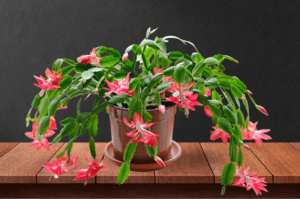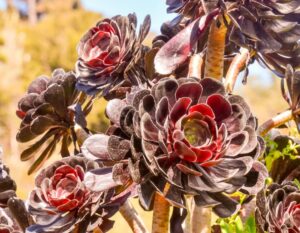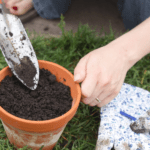Jade plants, Crassula ovata, are resilient succulent houseplants that can live for a long time with proper care. They have a tree-like appearance and can reach heights of three to six feet when grown indoors.
With their smooth, rounded leaves and easygoing nature, jade plants have become a staple in many homes. As succulents, jade plants are well adapted to thrive in low water conditions, making them an ideal low-maintenance houseplant.
But that doesn’t mean you can just stick them in a corner and forget about them! Proper care is still needed for your jade plant to truly flourish.
Jade plants thrive in warm, dry conditions and should be watered thoroughly during the growing season but allowed to dry out between waterings to prevent rot. In areas with colder temperatures, jade plants should be grown in containers and brought indoors when the temperature drops below 50°F.
Key Takeaways
- Jade plants are resilient succulent houseplants that can live for a long time.
- They thrive in warm, dry conditions and should be watered thoroughly but allowed to dry out between waterings.
- In colder temperatures, jade plants should be grown in containers and brought indoors when the temperature drops below 50°F.
- They have a tree-like appearance and can reach heights of six feet indoors.
- Jade plants require specific care and maintenance to ensure their health and longevity.
About Jade Plants

Jade plants are popular succulent houseplants that add a touch of greenery and elegance to any space. These decorative houseplants are known for their tree-like appearance and long-lived nature. With proper care, jade plants can be passed down from generation to generation, becoming cherished heirlooms in households.
The thick, woody stems and oval-shaped leaves give jade plants their signature miniature tree-like look. They are often kept indoors, where they adapt well to the warm, dry conditions found in most homes.
However, in mild and dry climates, jade plants can also be grown outdoors.
It’s important to note that while jade plants can handle direct sunlight, they are susceptible to cold damage and should be protected when temperatures drop below freezing.
You May Also Like: Your Guide To Christmas Cactus Care: Tips & Tricks
Planting Jade Plants
When it comes to planting jade plants, there are a few key factors to consider to ensure their successful growth.
First, choose a wide and sturdy pot that can support the top-heavy nature of jade plants. A moderate-depth pot will provide enough space for the roots to grow.
Next, it’s crucial to use well-draining soil to prevent root rot. A mixture of potting mix and perlite works well to create the ideal growing medium. This combination allows excess moisture to drain away, keeping the roots healthy and preventing waterlogged soil.
After planting, it’s important to give the jade plant time to settle and recover from any damage before watering it. This allows the plant to establish its roots and adjust to its new environment.
Once the plant is settled, water it thoroughly, ensuring the water reaches the roots. Allow the soil to dry out between waterings to prevent overwatering and root rot.
Propagating Jade Plants
If you want to expand your collection of jade plants or share them with others, propagating them from leaf or stem cuttings is a simple and rewarding process. Here’s how you can propagate jade plants:
Starting from Leaf or Stem-Cutting
To start propagating a jade plant, take a clean pair of clippers or scissors and cut a 3 to 4-inch section of a healthy stem. Make sure the cutting has a few pairs of leaves attached. Alternatively, you can propagate from a single leaf by gently twisting it off the stem.
Callous Formation and Rooting
Allow the cut end of the stem or leaf to dry in a warm place for a few days until a callous form. This callous helps protect the cutting and encourages root development. You can also dip the cut end in rooting hormone powder to speed up the rooting process.
Potting and Care
Once the callous has formed, prepare a potting mix of well-draining soil, such as a blend of potting mix and perlite. Place the stem-cutting or leaf on top of slightly moist soil, cover the cut end with soil, and gently press it down to ensure good soil contact.
For best results, keep the pot in a warm place with bright, indirect light.
Water the cutting sparingly, allowing the soil to dry out slightly between waterings. Overwatering can lead to root rot, so it’s important to strike a balance. Once the cutting develops roots and shows signs of new growth, you can gradually increase the amount of water.
Lighting Requirements for Jade Plants
Jade plants, being succulents, have specific lighting requirements to thrive and maintain their beautiful appearance. Adequate lighting is essential to encourage healthy growth and prevent legginess.
Jade plant care instructions require that they get at least 6 hours of bright light each day. Place your young jade plants in areas with bright, indirect sunlight.
This can be near east or north-facing windows, where the light is not too harsh.
As your jade plant matures and becomes well-established, it can tolerate more direct sunlight. South or west-facing windows in kitchens or offices are ideal spots for larger jade plants.
To ensure your jade plant receives sufficient light, rotate it every few weeks. This will ensure that all sides of the plant receive an even amount of light and prevent it from leaning towards the light source.
Signs of Insufficient Light
- Leggy growth: If your jade plant isn’t receiving enough light, it may stretch towards the light source, making the stem long and weak.
- Leaf drop: Inadequate light can cause the lower leaves of the plant to drop off.
- Pale leaves: If your jade plant’s leaves start to lose their vibrant green color and appear pale, it may be a sign of insufficient light.
Remember, while jade plants require bright light, it’s crucial to protect them from intense, direct sunlight, especially during the hottest parts of the day.
Insufficient light can cause your jade plants to become leggy and top-heavy, making them more prone to damage and unable to support their branches.
Temperature Considerations for Jade Plants
Understanding the ideal temperature range, cold tolerance, and how to avoid cold drafts will help you create the perfect environment for these resilient succulents.
Jade plants thrive at room temperature, typically between 65°F and 75°F. However, they prefer slightly cooler temperatures at night and during the winter months. Keeping your jade plants in a temperature-controlled environment will promote their growth and overall vitality.
It’s important to note that jade plants are not frost-tolerant. When temperatures drop below 50°F, it’s crucial to bring your jade plants indoors to protect them from the cold.
Additionally, during the winter season, it’s essential to keep your jade plants away from cold windows and drafty areas to prevent leaf drop and potential damage.
Watering Jade Plants
Proper watering is crucial for maintaining the health of your jade plants. It is important to find the right balance to ensure they thrive. One key factor to consider is soil moisture – jade plants prefer their soil to be slightly dry before watering.
Before watering, check the top inch of soil for dryness by inserting your finger. If it feels dry, it’s time to water!
The frequency of watering will depend on factors such as temperature, humidity, and the size of your plant.
As a general guideline, during the active growing season, water your jade plant deeply, allowing the excess water to drain out from the pot’s bottom. However, it’s essential to let the soil dry out between waterings to prevent overwatering and root rot.
Signs of Overwatering and Underwatering
To avoid common watering pitfalls, it’s important to be aware of signs of overwatering and underwatering. Overwatering can lead to drooping leaves, yellowing, and brown spots while underwatering can cause wilting, shriveled leaves, and leaf loss.
These signs indicate that your watering schedule may need to be adjusted to meet the needs of your jade plant.
- To prevent overwatering, ensure that your pot has adequate drainage to allow excess water to escape.
- Pay attention to the pot’s weight – a dry pot will feel much lighter compared to a saturated one.
- During dormancy in fall and winter, reduce watering and allow the soil to dry out fully between waterings.
Also Read: How To Water Succulents: Must-Know Tips For Optimal Growth
Fertilizing Jade Plants
While these plants have low nutrient requirements, providing them with the right fertilizers can help them thrive. Here are some important tips for fertilizing your jade plants:
- Understand the nutrient requirements: Jade plants require a balanced fertilizer that is low in nitrogen. Look for a liquid houseplant fertilizer or a specific cacti and succulent fertilizer that matches their needs. These fertilizers typically have a higher phosphorus and potassium content, which promotes root development and overall plant health.
- Choose the right fertilizer: Liquid houseplant fertilizers are easy to use and can be diluted according to the package instructions. Alternatively, you can opt for organic homemade plant fertilizers, such as compost or worm castings. These natural fertilizers can help provide the necessary nutrients without the risk of over-fertilization.
- Follow the fertilization schedule: Jade plants should be fertilized during the active growing season, which is typically in spring and summer. Start fertilizing once new growth appears, and continue every 4-6 weeks, following the package instructions for the specific fertilizer you are using.
- Apply the fertilizer correctly: Before applying the fertilizer, make sure the soil is moist. This will prevent root burn and ensure that the nutrients are evenly distributed. Dilute the fertilizer according to the package instructions, and apply it directly to the soil, avoiding contact with the leaves or stems.
Also Read: Benefits Of Using Eggshells In Houseplants
Repotting Jade Plants
Repotting jade plants is an essential part of their care routine, as it allows for proper growth and prevents them from becoming root-bound. To ensure the health and longevity of your jade plant, it is important to repot it at the right time.
The frequency of repotting depends on the size and age of the plant. Young jade plants should be repotted every 2 to 3 years to encourage growth and provide them with fresh soil and nutrients.
Older jade plants, on the other hand, can be repotted every 4 to 5 years or as necessary, especially if they have outgrown their current pot or if the soil has become compacted.
The best time to repot jade plants is in the early spring, just before the start of the growing season.
This allows the plant to recover quickly from the shock of transplantation and take advantage of the increased sunlight and warmth.
When repotting, choose a pot that is one size larger than the current pot to provide room for root growth. Use a well-draining potting mix specifically formulated for succulents or cacti to prevent waterlogged soil, which can lead to root rot.
After repotting, avoid watering the plant for about a week to allow the roots to adjust and heal from any potential damage during repotting.
This helps prevent the development of root rot and ensures the plant’s successful transition to its new pot.
Once the initial week has passed, resume regular watering, ensuring that the soil dries out between waterings to prevent overwatering and root issues.
Common Problems and Pests for Jade Plants
Pests and Diseases
Mealybugs and scale are two common pests that can affect jade plants. These tiny insects can be found hiding in the nooks and crevices of the plant, sucking sap and causing damage.
To treat these pests, wipe the leaves and stems with a soft cloth dipped in a mixture of water and rubbing alcohol. Repeat this process periodically until the infestation is under control.
Powdery mildew is another potential problem for jade plants, particularly in humid environments. This fungal disease appears as a white, powdery coating on the leaves.
To prevent powdery mildew, ensure good air circulation around your plant and avoid overwatering. If powdery mildew does occur, treat it with a fungicide specifically designed for houseplants.
Root Rot
Overwatering is the leading cause of root rot in jade plants. When the soil remains consistently wet, the roots can become waterlogged and prone to disease.
To prevent root rot, ensure that your jade plant is potted in well-draining soil and that the pot has adequate drainage holes. Only water the plant when the top inch of the soil feels dry.
Recommended Varieties of Jade Plants

If you’re looking to add some variety to your jade plant collection, there are several different types of jade plants to choose from. In addition to the standard green-leafed jade, there are also variegated varieties that offer a unique twist on this popular succulent.
- ‘Hummel’s Sunset’: features leaves that are yellow with red tips
- ‘Tricolor’: has white and cream variegation on its leaves
- ‘ET’s Fingers’: has tubular leaves with red tips
You May Also Like: 13 Unique Tall Succulents To Take Your Garden To New Heights
Wit and Wisdom about Jade Plants
Did you know that jade plants can be persuaded to flower by keeping them root-bound in a small pot and providing cooler temperatures during the winter? This little trick can help you enjoy the beautiful blossoms of your jade plant.
Another interesting aspect of jade plants is their longevity. These resilient succulents can live for many years, even decades, with proper care. This makes them not only stunning additions to your indoor or outdoor space but also meaningful gifts that can be passed down through generations.
FAQ
How often should I water my jade plant?
Water jade plants thoroughly during the growing season, allowing the soil to dry out between waterings. In the fall and winter, reduce watering and let the soil dry out fully between waterings.
Where should I place my jade plant for optimal light exposure?
Jade plants require at least 6 hours of bright light each day. Keep young plants in bright, indirect sunlight, while more established plants can handle more direct sunlight. South or west-facing windows in kitchens or offices are ideal spots.
What is the ideal temperature range for jade plants?
Jade plants grow best at room temperature, between 65°F and 75°F. They prefer slightly cooler temperatures at night and during the winter. It is essential to bring them indoors when the temperature drops below 50°F.
How often should I fertilize my jade plant?
Jade plants have low nutrient requirements and should be fertilized sparingly. Use a diluted mix of a standard liquid houseplant fertilizer or a fertilizer specifically made for cacti and succulents. Start feeding in the spring or summer when the soil is moist.
How often should I repot my jade plant?
Young jade plants should be repotted every 2 to 3 years to encourage growth, while older plants can be repotted every 4 to 5 years or as necessary. Transplant in the early spring, just before the growing season. Avoid watering for a week after repotting and wait at least a month before fertilizing.
What are common problems and pests that affect jade plants?
Jade plants can be susceptible to mealybugs, scale, and powdery mildew. Root rot can occur due to excessive moisture in the soil, while shriveled or wrinkled leaves indicate underwatering. Dropping leaves and squishy leaves suggest watering issues.
How can I encourage my jade plant to flower?
Keep your jade plant root-bound in a small pot and provide cooler temperatures during the winter to promote flowering. However, it’s important to note that jade plants rarely flower indoors.







